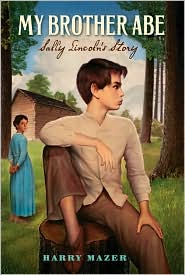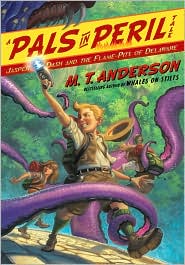Jeremy Fink and the Meaning of Life is the first Wendy Mass novel I've read, but it definitely won't be the last. Where to begin? This book has so much going on in it, from the philosophical to the theosophical, from mutant candy and found playing card collections to peanut butter sweat and the H.O.J., I know I will leave out one of the many, many enthralling, unique, creative, unparalleled details packed into this young adult book that reads like an adult novel. I don't know the last time I read this kind of soul searching, not in a solopsistic navel gazing sort of way, but in an actively searching and enquiring way, in a kid's book!
Jeremy Fink and the Meaning of Life begins almost exactly where it ends - on July 22nd, the day of Jeremy's thirteenth birthday. What happens over the course of the 278 pages in between is an epic search throughout New York City for four missing keys that will open the box that contains the meaning of life. No, this isn't a fantasy. A box, bought by Jeremy's father who died in a car accident five years earlier, and inscribed with the words, "THE MEANING OF LIFE: FOR JEREMY FINK TO OPEN ON HIS 13th BIRTHDAY," arrives a month before Jeremy's birthday. The box also comes with a letter from Mr Fink's lawyer explaining that he is in the process of moving his offices and has lost the keys to the four different locks on the box. From the moment he opens the package containing the box, Jeremy and his lifelong, polar opposite best friend Lizzy are up against a closet full of secrets, their own as well as those of others, and a suitcase full of keys with only 30 days to find the right ones.
The story really takes off when, caught trespassing in the empty offices of the lawyer, Jeremy and Lizzy are assigned community service the requires them to work for the pawn broker, Mr Oswald. However, this job turns out not to be as bad as the two expected. They are picked up in a limousine and driven to work - at Mr Oswald's house - by James, the tight-lipped but friendly chauffeur. Mr Oswald is in the process of moving and needs the children to deliver a few things for him. These turn out to be items that were pawned decades ago, when Mr Oswald's grandfather, Ozzy Oswald, ran the shop, and make up my favorite part of the book. When Ozzy ran the shop he had his underaged customers fill out a form explaining why they were pawning the particular item and what they intended to use the money for. Then he would take a picture of them with the item. They return a sixty year old autographed copy of Winnie-the-Pooh, a Tiffany lamp and an old brass telescope, along with the original letters they wrote for Ozzy. These make up some of the most poignant, probing, profound conversations of the book as the two talk with the people, now well into old age. They learn about the value of friendship, the freedom that comes with intentional simplicity - as a student of it, I appreciated the subtle, unnamed aspects of Buddhism that Mass weaves into her story, and the cosmic implications of time travel. Jeremy is constantly reading books about time travel, hoping to go back in time and prevent his father's accident. Dr Amos Grady, owner of the telescope and now a prominent astronomer working at the Museum of Natural History, helps Jeremy to understand that all the known laws of physics make time travel to the future an impossibility. And, while time travel to the past might be possible, with no way to get back to the future, "there would be two of you in the past an none of you here in the present. Theoretically, of course. Very Messy. Quite impractical."
Jeremy and Lizzy also make a detour to Atlantic City where, more than thrity-seven years ago, Jeremy's father had his fortune told by an old Russian woman who predicted he would die at the age of forty. Jeremy thinks that his father believed the prediction and that this was a governing factor in his life and thus the reason he arranged for the box to be sent to him on his thirteenth birthday. After a visit to a church and another answer to the question, "What is the meaning of life?" the two manage to track down a fortune teller with a Russian accent. Although the accent is an act, the woman really is the granddaughter of the fortune teller who predicted Mr Fink's premature death. It turns out that she was run off the boardwalk for making this prediction repeatedly to her male customers because she got bored making the usual pronouncements. Hoping for a bit of good luck, the two ask Madame Zaleski, the younger, where the keys to the box his father left him are. Madame seems to go into a trance and responds, "You have already been very near to zhe keys vich you seek, You vil find zhem, but it vil take much vork."
The community service tasks and the impossibility of ever finding the keys cause Jeremy to begin to question everyone he meets on there definition of the meaning of life, in case he can't get his box open to find his father's answer. He keeps track of his thoughts and observations in a notebook given to him by Mr Oswald as a means of recording his hours of community service. When there work for him is over, Mr Oswald allows Lizzy and Jeremy to each pick an item from his home to keep. Jeremy picks a suitcase full of the "flotsam and jetsam" that Mr Oswald removed from the drawers and pockets of items people brought to him, half of which are keys. Jeremy and Lizzy find all but one of the keys before embarking on their summer visit to Jeremy's grandmother's bed and breakfast in New Jersey where he will visit the state fair and celebrate his birthday. Lizzy surprises Jeremy with the fourth key, which she found in the suitcase but kept secret from him, as a birthday present. Sitting in a boat the middle of a lake where he used to fish with his dad, Jeremy and Lizzy open the box.
What is inside the box is fitting and serves as a moving conclusion to the journey Jeremy and Lizzy have taken over the course of the book. However, this is not the end. There is a twist that I will not reveal here...
Jeremy Fink and the Meaning of Life is an amazing book, to say the least. And, like I said at the beginning of the review, there are so many details that I have not included here and wish I could. Because Jeremy is twelve going on thirteen in this book it is often categorized as a young adult book. However, I think that this is a great book for teens, who might be able to better grasp the gravity of the different meanings of life discussed in the book, younger readers will enjoy the hunt for the keys and the many, crazy places it takes Jeremy and Lizzy.
Readers who enjoyed this book might like:
Every Soul a Star by Wendy Mass
Secret Letters from 0 to 10 by Susie Morgenstern
My One Hundred Adventures by Polly Horvath
Savvy by Ingrid Law
The Outcasts of 19 Schuyler Place by EL Konigsburg
My One Hundred Adventures by Polly Horvath
Savvy by Ingrid Law
The Outcasts of 19 Schuyler Place by EL Konigsburg
With discretion, I highly recommend, for older readers, I am The Messenger by Markus Zusak. This book will keep rolling around in your head for months after you finish it. The main character in the story is eighteen when he inadvertenly thwarts a bank robbery. That's when the first Ace arrives with instructions for him to follow. An unseen mentor sends him on a journey, guided by messages on playing cards, that leads him to a new perspective on life. There is adult language and a scene involving off-the-page sexual violence.











